Chapter 7
DIRECTING
Directing literally means Moving in to action. It is
the 4th function of management and is considered as the Heart of Management.
It is the process by which a manager guides his subordinates for the attainment
of goal planned by the organization. It deals with issuing orders and
instructions, motivates, leads, creates good working environment and oversees
the employees to do the best of their abilities. It sets organization on motion
and ensures proper performance. If subordinates are not properly directed
planned objectives will be on the paper. So in short, we can say directing
means managing the people and their activities in an organization.
It is the function to be performed by all managers from top to bottom level and in all stages.
Directing plays very important roles in an organization,
which can me understand through the following points:
1. Initiate
action:
Directing initiates the action of subordinates by
giving orders and instructions, motivates leads and oversees them in a preplanned
manner to achieve the planned objective. Without proper direction other
functions of management remains ineffective.
2. Integrates
employees’ efforts:
Directing coordinates the efforts of employees for the goal achievement. For that purpose through effective communication, supervision, guidance and counseling directing creates mutual understanding and team work among them.
3. Direction is
the means of Motivation:
Each and every
individuals working in an organisation have some caliber. This caliber cannot
be use fully if there is no proper direction. Directing helps the employees to
use their caliber to their maximum by motivating them towards the realization
of business goals.
4. Direction
provides stability and balance in the organisation:
Organisation
has a goal, at the same time each members also have their own objectives. These
goals always not match each other, which results in conflict. Through proper
communication, leadership and motivation directing maintain a balance between
these goals and thereby ensures stability.
5. Direction
facilitates changes in the organization:
Modern
business environment changes very frequently. So for the growth and expansion
organization must be adjusted with the changes.
Directing helps the organization to adjust with the changing conditions
through proper and better communication and leadership.
ELEMENTS OF DIRECTING
Following are
the four elements of directing:
A. Supervision
B. Motivation
C. Leadership
D. Communication
SUPERVISION
The term SUPERVISION
is made up of two words, ‘SUPER’ and ‘VISION’. Meaning of ‘super’ is from above and ‘vision’
is observing. Thus supervision means overseeing from
above.
Workers will
be careless and waste their time while at work unless someone oversees their
activities. This overseeing process which instructs, guides, controls and keep in track the
employees efforts and ensures they are doing as per plans and policies of the
organization is termed as supervision. It is an authoritative watch over the
subordinates. It is concerned with
direct and immediate guidance and control of subordinates in the performance of
their task.
SUPERVISOR AND HIS ROLE
Supervisor is
a person who is in charge of a section and members there. He has a great role
in the organization as he has direct touch with the workers. He communicates
the plans, policies and decisions of the management to the workers and reports
grievances and complaints of the workers to the management. So he protects and
promotes the interest of both workers and management and act as a link between
them.
Supervisor is
responsible to ensure quality and quantity of products as per plan, proper
maintenance of equipments to get maximum capacity, proper utilization of
resources and to give proper training to his subordinates.
Supervisor is also known as Foreman, Overseer, Superintendent, Section officer, Section in charge etc.
IMPORTANCE OF SUPERVISION
The following
points explain the importance of supervision:
1. Initiates
Action:
For initiating
the action of workers directing issue order and instructions to them and tells
what to do and how to do. Directing
perform this activity through its element supervision. Supervision also guides
the workers, solves their problems and ensures that the work is performed as
per plan. Thus, supervision sets into motion human and physical resources for
accomplishing the objectives.
2. Helps Control:
Supervision watches
the subordinates at work and controls their performance by comparing their
finished work with the standard set as per plan. It also ensures all works are
going according to the plans, policies and procedures. If fine any significant
deviations in the performance of subordinates, it takes remedial measures. These
steps involve the process of controlling. Thus, supervision facilitates
control.
3. Helps Optimum
utilisation of resources:
By constant
watch on the performance of employees, the supervisors can ensure progress of
the work in the right direction. This leads to minimise wastage of time and
resources. So we can say supervision helps to utilise all resources at maximum.
4. Ensure
discipline in the organisation:
Supervision
ensures discipline in the work. This is possible through close monitoring,
guiding and instructing the employees while in work. This ensures plans and time schedule are
strictly followed and take corrective action, If found any deviations.
5. Helps in
getting feedback:
Supervisors are in
direct touch with the workers. As a result feedback in the form of view points,
suggestions, grievances and even complaints will b received. This can be passed
on to the management, which helps to improve the quality of management
decisions.
6. Improves the
quality of communication:
Supervision
improves communication at various levels of management and an important linking pin between management
and workers. They give instructions to workers about the work and report the
progress of work to the management. This two way communication helps in improving the quality of
communication by better understanding of needs, aspirations and problems of
people at different levels of management.
6. Facilitates
Motivation:
Supervisor inspires and stimulates the subordinates to do their maximum for the goal achievement of the organisation. They motivate the workers by appreciating the workers for their good performance. More over it also creates team spirit among the workers.
MOTIVATION
By birth man is
lazy in nature. To make him active, it is necessary to create some desires in
him and leads to our way. Without making them active, it is impossible to
achieve the planned goal. This active
making element in an organisation is known as Motivation.
Motivation means inspiring people with enthusiasm to work and extend their cooperation for the goal achievement. It is the process of channelizing a person’s inner needs to take a course of action decided by other people. Motivating a worker means creating a need and desire on the part of a worker for the bettering his present performance or increases his contribution towards the goal achievement. Thus motivation is considered as the core of management.
Motivation is a psychological phenomenon and a continuous process. It is essential at every level of management and at every stage of the organisational process.
IMPORTANCE OF MOTIVATION
Motivation is one of the most important element of directing which inspire and encourage subordinates for getting best result from them. The following points make clear the importance of motivation.
1. Initiate action among people:
Motivation creates willingness among workers to work and enable the management to secure the best possible utilisation of physical and financial resources. This means motivation puts subordinates in to action. Motivation creates a 'will to work' among the employees, which is essential for getting work done effectively.
2. Improves efficiency and performance level:
Motivated employees put higher performance and help in increasing productivity, reduce cost of production and secure overall efficiency. It bridges the gap between capacity of work and willingness to work. This means the performance of employees will depend up on their ability and willingness to work hard. Motivation is essentially goal directed, therefore, higher the motivation, the better the goal accomplishment.
3. Ensures
accomplishment of organisational goals:
4. Creates better industrial relations:
Motivation creates a friendly and supportive relationship between employer and employee by offering various rewards, promotional opportunities, etc to employees to satisfy their wants and needs. This satisfaction helps to reduce absenteeism and industrial disputes and increases the morale of the employees.
5. Helps to
accept organisational changes:
Effective motivation helps to overcome resistance to change. Motivated workers will accept all the changes for the betterment and advancement of the organisation. This is because they identify their own advancement with the prosperity of the organisation
6. Reduces employees’
turnover and absenteeism:
Motivation
creates confidence in the subordinates and secures their loyalty to the
organisation. As a result the rate of absenteeism and labour turnover are
reduced. This helps to maintain a stable work force in the organisation, so the
organisation can enjoy the skill and experience of its employees for a long
period of time.
MASLOW’S NEED HIERARCHY
Motivation is a mental stage arising from needs and
wants of individuals. For motivating the workers a manager must understand
their needs and wants.
Psychologist Abraham H. Maslow developed a conceptual frame
work for understanding the nature of human needs, which are based on two
points:
1. Only those needs yet not satisfied can used as a
motivating factor to influence the behaviour of people. Fully satisfied need
cannot influence behaviour.
2. Needs can be arranged in a hierarchy of importance.
Maslow arranged the human needs in a hierarchy as follows:
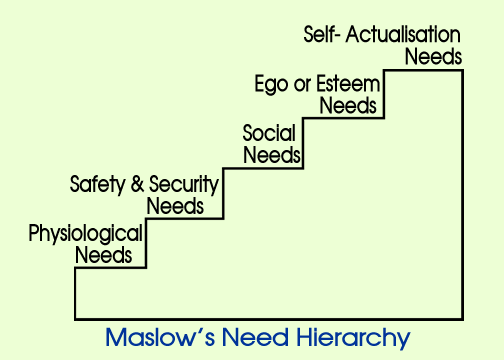
A. Physiological Needs:
They are the primary needs of human beings which are
related to survival and maintenance of human life. Such needs are repetitive in
nature and include necessaries of life such as food, clothing, shelter, air,
water, sex etc. If the basic needs are not met human beings will not expect higher
order needs.
B. Safety and Security Needs:
Once physiological needs are satisfied people want to
ensure that they continue to satisfy these needs even in future without any
interruption. This makes human beings a feeling of security. People want
physical, economical and social securities.
Physical Security includes protection
against fire, accidents, crime and other types of physical dangers. Economic Security implies seeking
assurance for the availability of money for the fulfillment of basic needs on
continuous basis. Social Security implies need for security in old age, stage
of illness etc.
C. Social Needs:
Safety and security needs are satisfied leads to the
third stage in the hierarchy, i.e., social needs. In this stage a person will
like to make good relationship with others. These needs include the need
for love and be loved and the need to belong and be identified with a group. Most
of the people satisfied these needs by making friendship with other people in
the job, society, etc.
D. Ego or Esteem Needs:
Satisfaction of social needs gives rise to the next
higher level needs, i.e., Ego or Esteem needs. This needs include self-respect,
self-confidence, feeling of being unique, respect from others, appreciation
from others, status, prestige in society, power and control etc. The organisation can satisfy
these needs by appreciating good performance, providing challenging job and
giving an opportunity to feel a sense of achievement etc.
E. Self-actualisation Needs:
Self actualisation is the last need in this hierarchy. It is the need to become more and more what one can become. It involves self fulfillment and maximum possible degree of achievement. Maslow defines these needs as the 'desire to become everything one is capable of becoming'.
LEADERSHIP
Leadership is a process of influencing and directing the performance of an individual or a group for goal achievement in a given situation. It is a process of influence, guides, directs, and controls the thoughts, feelings and behaviour of the followers. It makes people in different character move towards a common goal and creates a co-operative spirit among them. It is a personal skill either in born or acquired. The success of an enterprise largely depends up on the quality of its leadership. Every manager is a leader as he has to coordinate the efforts of people to achieve the business goals.
Following are the four main features leadership;
- Its purpose is to influence the behaviour of the followers.
- It is a process of interaction between persons.
- It is for the achievement of individual interest as well as group interest.
- It is the process of obtaining willingness and cooperation of followers.
IMPORTANCE OF LEADERSHIP
Leadership is an important factor for an organization’s success which can be understand form the following discussion;
1. Helps in motivating and guiding the employees
Motivation and
guidance are necessary for getting better work performance. A leader by
exercising his leadership quality motivates and guides the potential abilities
of employees towards the attainment of business goals. Good leadership in the
organisation itself is a motivating factor for the individuals.
2. Basis for co-operation of members
Organisation
becomes successful only when they can secure the co-operation of their
subordinates. Good leadership builds a harmonious relation between subordinates
and management and leads the workers enthusiastically, create team spirit and
promote co-operation among them.
3. Creates Confidence
Sometimes employees fail to recognize their qualities,
skill and capabilities to work. Leaders by using his superior knowledge create
confidence, provide psychological support and inject the spirit of enthusiasm
in them, which is essential for doing things.
4. Increases efficiency and productivity
The effective utilisation of all resources is a key factor for the attainment of business objectives. Leadership aims at creating and maintaining a satisfactory environment for utilizing all resources and for employees to contribute their maximum effort towards the attainment of group goals.
5. Create job satisfaction among employees
Providing good condition at work place, maintaining good relationship with workers, making good behavioural attitude towards workers, etc. create job satisfaction among the workers. Leaders guide the employees, while they are performing uncertain, vague and difficult jobs.
6. Enhances group efforts
Good efforts are the result of mutual trust, linking friendliness and co-operation. Leaders create team spirit at work place. Leadership encourages subordinates to share the common interests and to work collectively towards the attainment of organisational goals.
QUALITY OF A GOOD LEADER
Leadership is
the function of leader. It is leader who creates enthusiasm among his followers
and inspires them to move towards the objectives. So he has the ability to
influence people and make them his followers. A good leader should have the
following qualities:
1. Intelligence and Scholarship
A good leader
should be highly intelligent. He should have the ability to think logically,
analyse the situation accurately and interpret the problems clearly. He should
possess good judgment and decision making abilities. He has the capacity to
identify the feelings of his followers and have a logical bent of mind and
mature outlook.
2. Communication Skill
A good leader should be a good and effective communicator. He should be able to communicate clearly, precisely and effectively. It is necessary to influence others and to co-ordinate their efforts. This will also enable him to maintain good relationship with followers and understand their problems and feelings.
A good leader
always listens to others problems. He have the ability to listen patiently and
understand what others saying.
4. Ability to inspire and guide followers
A good leader
should have the ability to inspire and guide the followers. He tells the best possible
way for doing a job. This helps the workers to do work with great involvement
as a team.
5. Self confidence and Sense of responsibility
A good leader
must have self-confidence and a strong will power. He should have confidence in
his ability to lead others and the will power to meet the needs of every
situation. He also have a sense of responsibility towards the attainment of
goals. He motivates himself and develops an urge to accomplish the objectives.
6. Empathy
The ability to look at things from others’ point of view is known as empathy. For motivating his subordinates, a good leader must understand their needs, aspirations and outlook. Empathy also helps a leader to anticipate the effect of his behaviour on followers.
COMMUNICATION
The word
communication is derived from the Latin word ‘Communis’ which means ‘Common’.
Thus communication involves sharing of ideas in common. It means exchange of ideas, facts, opinions, emotions or information between two or more persons to create a common ground of understanding. I other words it is the process of conveying the message from one person to another. It is a bridge of meaning and a continuous process of telling, listening and understanding.
Elements or Process of Communication
Communication is a two way process. It starts by sending a message by the sender and ends with the feedback by the receiver to that message. Communication process will come to an end only when the receiver understands the message in the same sense what the sender means. The following chart shows a clear picture about it:

1. Sender:
The person who communicates the message is known as sender or
Communicator. He is the person who starts the process of communication by transmit
a fact, idea,opinion or other information to someone else.
2. Message:
Message is the subject matter of communication. It is what is sender likes to convey to receiver. It may involve any fact, ideas or information that exist in the mind of the sender.
3. Encoding:
Generally sender conveys the message in a meaning full language. For transmitting it must be converted in to certain symbols like words, pictures, diagrams, etc. The process of conversion of message in to symbols is known as encoding.
4. Channel:
It is the way or route through which the message is passed from the sender to receiver. It may be face to face talk, telephone, letter, radio, television, etc.
5. Receiver:
Receiver or cornmunicatee is the person or group who is supposed to receive the message. He may be a listener, a reader or an observer. He tries to understand the message.
6. Decoding:
The process of converting the encoded message in to meaning full language is known as Decoding. For understanding and interpreting the meaning of message by the receiver, it must be decoded.
7. Feed back:
Feedback is the response or reply to the message by the receiver to the communicator. It indicates in which way the receiver understand the message. It is essential to ensure that the receiver understand the message in the same sense what the sender wants.
Communication Network
Pattern through which members of a work group communicate is known as communication network. Generally, there are five communication net works, which are given as follows:
1. Wheel pattern:
In the wheel pattern, communication flows from one central person who is generally the group leader. It is the most centralized pattern of communication network. In this communication all the members are communicate only with the help of group leader. Following figure gives a clear picture about it:
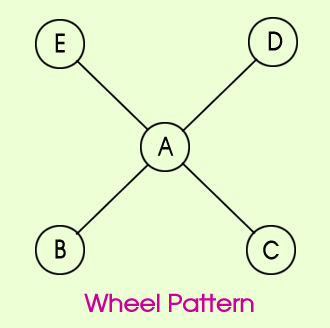
2. ‘Y’ pattern:
The 'Y' pattern is slightly less centralized. In this pattern some persons are closer to the center of the network. In this network some members can directly communicate to other members. Following figure gives a clear picture:
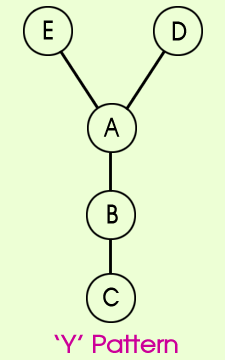
In the chain pattern, first and last members can only directly communicate with one member, but other members can directly communicate with two members. It offers more flow of communication than wheel pattern and 'Y' pattern. Following figure gives a clear picture about it:

4. Circle pattern:
The circle pattern permits each person in the group to communicate with two members in the group. Following figure gives a clear picture about it:
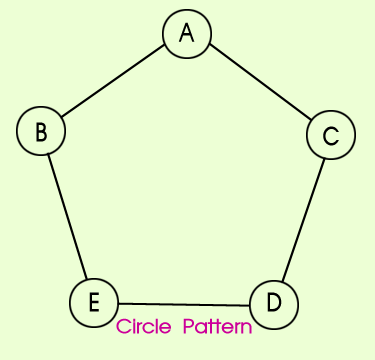
5. All channel pattern:
This network permits all the members to communicate with each other in the group. This is the most decentralized from of network and allows free flow of communication following figure gives a clear picture about it:
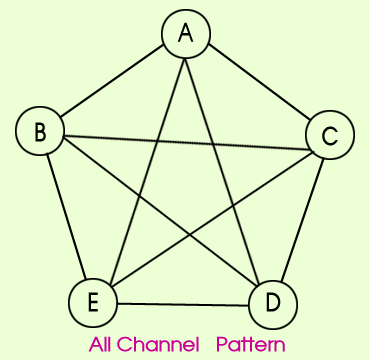
Importance of Communication
Communication is essential. Efficiency of management is based on
effective communication. The following points explain the importance of
communication.
1. Helps in achieving organisational objectives
Organizational objectives are set by the management and it is achieved through the efforts of all employees at different levels in the organisation. So the objectives must be clearly understood by all employees. This is possible only when there is an effective communication system. Thus, an effective communication system is essential for accomplishing objectives successfully.
2. Provides necessary data for planning and decision making.
Good decisions are possible only when proper information is communicated to the management. Communication provides right information at the proper time for sound planning and decision making. This enables managers to understand the problems and for making sound decisions.
3. Establishes authority and responsibilities
Due to the implementation of the management principle ‘Division of work’, each worker is doing only a part of a work. So it is essential to establish the authority and responsibility relationship in the organisation, which helps to coordinate all the activities to get the work done. A well defined communication system helps the management to establish authority responsibility relationships, which facilitates co-ordination between different departments and different activities.
4. Helps in securing acceptance for organisational rules by subordinates
Communication between superior and subordinates helps to make a clear understanding about the rules and regulations to the subordinates. It also helps to improve the relationship between them.
5. Helps in motivation and morale
Motivation and morale of employees can boost up through proper communication. Sharing of information with employees helps management to secure their willing cooperation. A manager can motivate his subordinates by using appropriate words to command their performance. When the employees are fully informed about n the plans, job changes etc, their motivation and morale are very high, because they know what they are supposed to do.
Forms of organisational Communication
Following are the two types of communication generally we can see in an organisation:1. Formal communication.
2. Informal communication.
Formal Communication